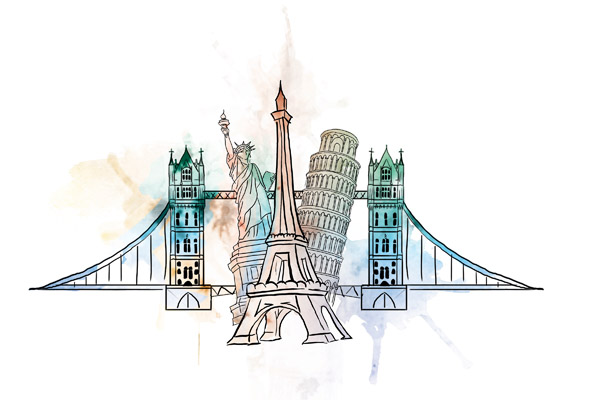What Makes a City “Great”?
Illustrated by JINAN PAQUIN
The following article was written for the Transforming Futures exhibition, taking place in late March, early April 2012 in the Warren G. Flowers gallery at Dawson College. The exhibition explores the future as a place of unbound invention and extraordinary possibility.
When we think about the great cities of history, which cities come to mind? Florence? London? New York? What makes them “great” to us? Is it size? Florence, London and New York all are, or were, big relative to their time, but a city could be big without being great. Is it influence that makes a city great? Florence, London and New York rank among some of the most influential cities, in terms of their impact on culture, politics, economics. Yet that impact has not been uniformly positive. So again, what makes a city great––in the past, now, and in the future?
 Let us start by wondering why we cluster together as a population in such a high density, exchanging goods, developing ideas, and building institutions, in the first place. The first cities are speculated to have arisen around 7,000 years ago, in Mesopotamia. These cities arose out of a need for an irrigation system which would make agriculture possible in an area plagued by low rainfall. The only major sources of water were the two large rivers, the Tigris and the Euphrates. Even these rivers were not reliable, however, as they were prone to flooding. Mesopotamia’s large cities thus arose in an effort to control the naturally volatile nature of the elements in the region, and out of an understanding that only through cooperation would the inhabitants have a greater chance of survival.
Let us start by wondering why we cluster together as a population in such a high density, exchanging goods, developing ideas, and building institutions, in the first place. The first cities are speculated to have arisen around 7,000 years ago, in Mesopotamia. These cities arose out of a need for an irrigation system which would make agriculture possible in an area plagued by low rainfall. The only major sources of water were the two large rivers, the Tigris and the Euphrates. Even these rivers were not reliable, however, as they were prone to flooding. Mesopotamia’s large cities thus arose in an effort to control the naturally volatile nature of the elements in the region, and out of an understanding that only through cooperation would the inhabitants have a greater chance of survival.
The idea of survival alone, however, is not adequate to understand what makes a “great” city. New York, for instance, was not founded on the basis of survival––it was a settlement in the New World. However, because the cities of Mesopotamia offered a degree of safety and security previously not available, its people (those with means, in any case) were free to devote their time to concerns beyond survival, in particular to intellectual and artistic concerns. The cities of Mesopotamia, therefore, like Florence, London and New York, facilitated not only survival but also the advancement of culture and civilization, which, at least intuitively, seems to be an important component of any city we consider “great.” Florence, for instance, was famous during the Renaissance not because of its military might but because it cultivated an environment in which some of the greatest art was produced.
Other cities throughout history have been recognized as hubs for achievements in a range of intellectual fields across both the arts and the sciences, and these achievements have, similarly, helped us advance civilization as we know it. However, if the advancement of civilization is part of what makes a city “great,” what might a great cities of the future look like?
It seems, to begin, that a great city of the future should be safe and secure. The kinds of achievements for which many cities have become famous are only possible when one does not have to worry about a flood every spring. Many of cities we think of as “great” also displayed longevity, as if takes a city a while before it can achieve the heights that grant it access to the city hall of fame.
Many cities and indeed civilizations have also fallen from those heights because of their failure to be economically, politically, and environmentally sustainable. The demands of greatness––overspending, disregard for the environment, population growth––can become an unsupportable burden on a city as well. Therefore, sustainability will also be an important quality of a great city of the future.Beyond security and sustainability, a great city of the future will have to make available to its people the tools with which they can not only survive but thrive, with which they can advance culture and civilization for the benefit of humankind. Partly, this will mean education––education that teaches people not only how to fit into society as it is currently structured but also how to find and build new structures, in our imaginations and in reality, that will help us fulfill our human potential.
There has historically been a competitiveness among cities and civilizations for the mantle of greatness––think of the clamour around who won the most gold medals at the Olympics every four years––but what has made cities great has been not only that they met the criteria outlined above (and others) but also that they met those criteria better than anyone else. Therefore, planners of the cities of the future cannot hope to simply repeat past successes. Instead, innovation is key, which means that the question of what makes a great city is one we will need to be forever asking.

Comments
No comments posted yet.
You have to be registered and logged in in order to post comments!